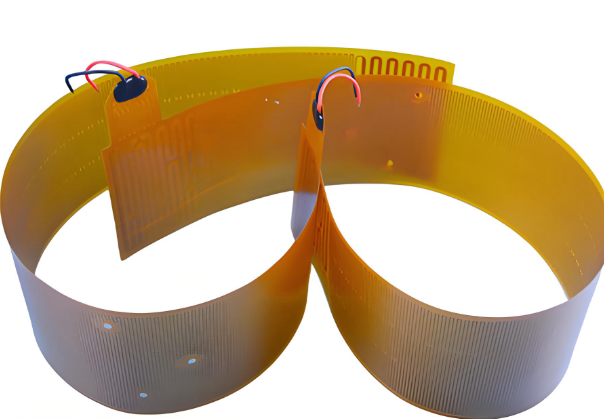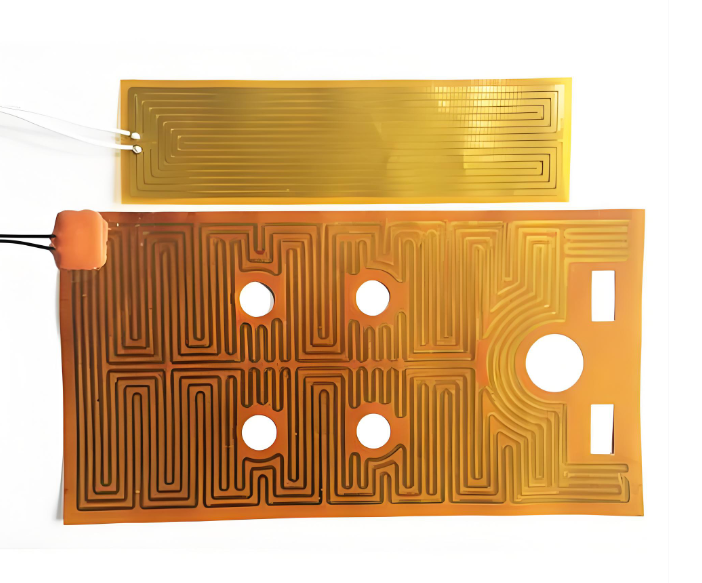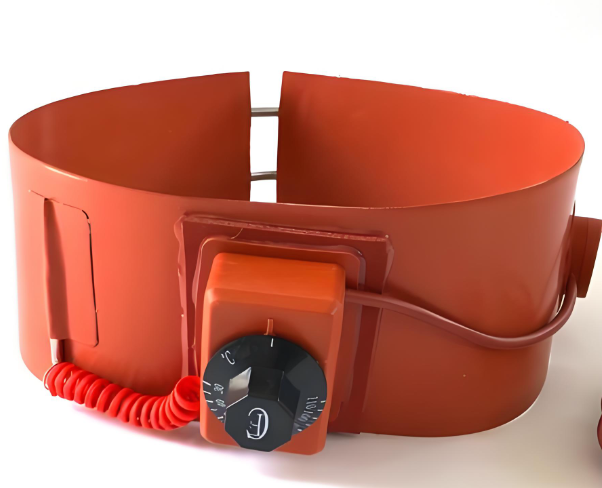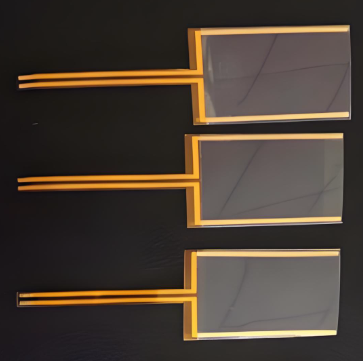An etched foil heating element has become one of the most reliable and advanced solutions for precise, uniform, and rapid heating. Unlike traditional wire-wound or carbon-based heaters, this modern design uses a thin metal foil etched into complex patterns and bonded to an insulating film like polyimide (PI) or silicone rubber. The result is exceptional heat transfer efficiency, faster response time, and superior temperature control.
These heaters are now essential in aerospace systems, medical instruments, automotive components, and industrial manufacturing — wherever precise temperature stability is vital.
An etched foil heating element is a thin, flexible heater created by chemically etching a resistive metal foil — such as Nickel-Chromium (NiCr), Copper-Nickel (CuNi), or Stainless Steel (SS304/316) — into a predetermined pattern. This pattern defines how heat spreads across its surface. The etched foil is then sandwiched between high-performance insulating films like polyimide (Kapton) or silicone rubber.
Because the foil’s structure is flat and continuous, it provides uniform heating across the entire surface, avoiding the hotspots and uneven temperature zones often found in wire-based designs. The overall thickness can be as thin as 0.2 mm, enabling integration into compact devices, curved surfaces, and high-density electronic assemblies.

When an electrical current flows through the etched metal foil, Joule heating occurs — electrical energy converts into thermal energy. Because the foil’s pattern is finely engineered, heat spreads evenly and quickly.
The large surface area of the foil enables instant heat transfer to the bonded surface or component. For example, polyimide-based etched foil heaters can reach up to 260°C, while silicone-based heaters maintain excellent performance under vibration, humidity, and mechanical stress.
Moreover, these heaters can integrate thermistors, RTDs, or thermocouples for real-time temperature monitoring, forming a closed-loop control system. That’s why they are very suitable for battery packs, optical modules, and medical incubators, where temperature consistency is crucial.
Etched foil heaters are available in several material configurations, each tailored to different thermal and mechanical requirements.
1. PI Flexible Heaters
Polyimide-based etched foil heaters are ultra-thin, lightweight, and suitable for applications where space is limited. They perform well under temperatures up to 260°C and are ideal for aerospace, electronics, and battery heating systems. Their high dielectric strength and excellent chemical resistance make them reliable even under harsh conditions.

2. Silicone Rubber Heaters
Silicone rubber etched foil heaters combine flexibility with durability. The silicone encapsulation provides moisture resistance and mechanical strength, making them perfect for outdoor or industrial environments. They are widely applied in freeze protection, industrial pipe heating, and laboratory instruments where stability and longevity are crucial.

3. Transparent Heaters
Transparent etched foil heaters are developed for optical devices and display applications. By integrating conductive metal mesh or transparent conductive films, they maintain up to 90% transparency while generating uniform heat. These are often used in camera lenses, mirrors, and vehicle windshields to prevent fogging or icing.

Etched foil heaters come in different colors based on their insulation materials or visual identification requirements:
Commonly used for applications requiring high visibility and quick identification, especially in industrial control systems and testing instruments.
Often preferred in eco-energy equipment and environmentally themed devices, symbolizing sustainability and efficiency.
Favored in automotive and consumer electronics, where the color aids visual detection and enhances aesthetic harmony in assembled products.
Though color differences mainly stem from material properties and manufacturing processes, thermal and electrical performance remains consistent across all variants.
In industries where energy saving, stability, and precision are key, etched foil heaters provide measurable performance improvements.
The main function of the etching heating film is to etch other substances at high temperatures. It can be etched by conducting heat, making the etching process more uniform and efficient. In addition, the etching heating film can also be used in thermal resistors, thermal resistors, and thermal circuits, etc.
By adjusting the voltage or current, precise temperature control of the heating area can be achieved, suitable for anti-freezing, constant temperature and other scenarios.
In each field, the combination of fast response, precision, and flexibility gives the etched foil heater a performance edge.
Both designs generate heat through resistance, but etched foil technology significantly outperforms wire-based solutions:
| Feature | Etched Foil Heater | Wire-Wound Heater |
| Heat Uniformity | Excellent — even across entire surface | Uneven, often causes hot spots |
| Thickness | Extremely thin (<0.2 mm) | Bulkier due to wire spacing |
| Response Time | Instant heating and cooling | Slower due to higher thermal mass |
| Customization | Complex, fine circuit patterns possible | Limited to basic shapes |
| Energy Efficiency | High | Moderate |
| Durability | Resistant to vibration and fatigue | Wires may loosen or break |
Modern new energy equipment—such as electric vehicles, solar systems, and energy storage modules—demands precise temperature control and high efficiency. Etched foil heaters meet these needs through three major strengths:
1. Uniform Heating Performance
Traditional wire-based heaters often generate uneven heat, leading to local overheating and energy waste. Etched foil heaters, with precisely etched circuits, provide consistent surface heating.
2. Accurate and Responsive Temperature Control
In energy devices like battery modules or fuel cells, temperature fluctuations can cause inefficiency or damage. Etched foil heaters integrate easily with smart sensors for real-time feedback, enabling accurate heat regulation. Their resistance can be fine-tuned to achieve the exact temperature needed for safe and efficient operation.
3. Lightweight and Compact Structure
New energy systems aim for compactness and weight reduction. The thin and flexible etched foil heater fits seamlessly into tight spaces without affecting structural design. For wearable or portable energy devices, this lightweight form supports longer usage times and improved comfort.
At Danyu Electronics, we understand how critical thermal management is to modern electronics and industrial systems. As a professional PCB and flexible heating solution manufacturer, we provide custom etched foil heating elements designed to match your exact application requirements.
Our engineering team utilizes advanced etching and lamination equipment to create complex heating circuits with exceptional accuracy. Each heater undergoes strict quality inspection, thermal uniformity testing, and electrical resistance verification before delivery.
Whether you need polyimide foil heaters for precision instruments or silicone etched foil heaters for outdoor equipment, Danyu Electronics can deliver reliable, customized, and cost-effective solutions. Our products are widely used across Europe, North America, and Asia for their dependable performance and superior craftsmanship.
1. What is the typical operating temperature of an etched foil heating element?
Polyimide types typically operate up to 260°C, while silicone-based heaters handle continuous use around 200°C and short bursts above that.
2. Can etched foil heaters be used outdoors?
Yes, silicone-insulated etched foil heaters perform well in outdoor or humid environments thanks to their moisture resistance and mechanical strength.
3. How is power density determined in etched foil heaters?
Power density depends on the foil’s resistance pattern and applied voltage. Designers adjust these parameters to reach the desired heat output without overheating.
4. Are etched foil heaters customizable in shape and size?
Absolutely. They can be designed in almost any shape, from circular and rectangular to irregular geometries that fit unique surfaces.
5. Does Danyu Electronics provide rapid prototyping for etched foil heaters?
Yes, Danyu Electronics offers fast-turn prototypes with complete design verification and quality testing to help customers shorten development cycles.
Simply drop your email or phone number in the contact form, and we'll promptly reply you shortly.